Effect of Blade Profile on Flow Characteristics and Efficiency of Cross-Flow Turbines
Abstract
1. Introduction
1.1. Background and Motivation
1.2. Principles of Flow Characteristics and Operation
1.3. Turbine Configuration and Design Approach
1.3.1. Nozzle Design
1.3.2. Operating Parameter
1.3.3. Blade Geometry and Runner Design
1.3.4. Performance Evaluation
2. Methodology
2.1. Blade Profile and Turbine Specifications
2.2. Computational Setup
2.3. Mesh Sensitivity and Grid Convergence Study
- ☞
- is the relative error between the mesh level i (coarse) and j (finer)
- ☞
- torque on the coarse grid
- ☞
- torque on the finer grid
2.4. Boundary Conditions and Turbulence Modeling
2.5. Numerical Solution and Governing Equations
- ☞
- Continuity equation (mass conservation):
- ☞
- Momentum conservation (in rotating frame)
- ☞
- Effective viscosity using the SST model
- ☞
- Homogeneous two-phase mixture properties
2.6. Simulation Scenarios and Performance Evaluation
3. Results and Discussion
3.1. Velocity Field and Flow Component Analysis
3.1.1. Tangential Velocity Component
3.1.2. Radial Velocity Component
3.2. Pressure Distribution Analysis
3.3. Water Volume Fraction Distribution
3.4. Influence of Runner Speed and Blade Geometry on the Internal Flow Behavior
3.4.1. Flat Blade Profile
3.4.2. Round Blade Profile
3.4.3. Sharp-Edged Blade Profile
3.4.4. Aerodynamic Blade Profile
3.5. Comparative Hydraulic Performance Study
3.6. Torque and Power Output
3.7. Stage-Wise Efficiency Analysis
3.7.1. First Stage: Primary Energy Extraction Zone
3.7.2. Second Stage: Secondary Energy Recovery Zone
3.8. Influence of Blade Geometry on Stage-Wise Efficiency
- ☞
- Flat blades show a higher second-stage contribution at lower speeds (e.g., 38% at 540 rpm), but their performance degrades as the speed increases. At 940 rpm, the first stage dominates with 50%, yet the overall efficiency remains modest due to the severe turbulence.
- ☞
- The round blades deliver peak first-stage efficiency (~53%) at 670 rpm, while the second-stage efficiency peaks (~27%) at 540 rpm, reflecting relatively balanced yet moderate performance.
- ☞
- Sharp blades reach maximum first-stage efficiency (62%) at 940 rpm and highest second-stage contribution (~27.5%) at 670 rpm, but exhibit sensitivity to off-optimal conditions.
- ☞
- Aerodynamic blades consistently yield the best results, achieving up to 83.1% total efficiency at 940 rpm, with over 70% of the energy extracted during the first stage. At 540 rpm, these blades attain an overall efficiency of 72.2%, with a well-balanced stage-wise contribution.
3.9. Exit Pressure Trends and Blade Geometry Influence
- ☞
- At 270 rpm, the aerodynamic blades achieved the lowest exit pressure (6.62 kPa) with moderate efficiency (44.6%), while the sharp blades, despite a higher exit pressure (9.98 kPa), delivered the highest efficiency in this speed regime (Figure 27). The round blades exhibited a moderate pressure level (7.95 kPa) but yielded the lowest efficiency (42.4%).
- ☞
- At 540 rpm, all blade types experienced a drop in the exit pressure. The aerodynamic blades reached peak efficiency (72%), demonstrating superior jet deflection and energy recovery potential. Round and sharp blades followed closely, while flat blades continued to underperform.
- ☞
- At 670 rpm, the sharp blades achieved maximum efficiency (79%), albeit with higher exit pressures, suggesting a trade-off between pressure buildup and momentum transfer. Aerodynamic blades maintained high efficiency while also minimizing pressure spikes, indicating robust flow control and favorable blade-jet interaction.
- ☞
- At higher runner speeds (800–940 rpm), exit pressures significantly increased across all profiles, with flat blades peaking at ~15 kPa, corresponding to the lowest efficiency (76.5%) in this regime. The aerodynamic blades retained their dominance, maintaining exit pressures below 10 kPa and achieving efficiencies exceeding 83%, attributed to their streamlined profile and reduced wake turbulence.

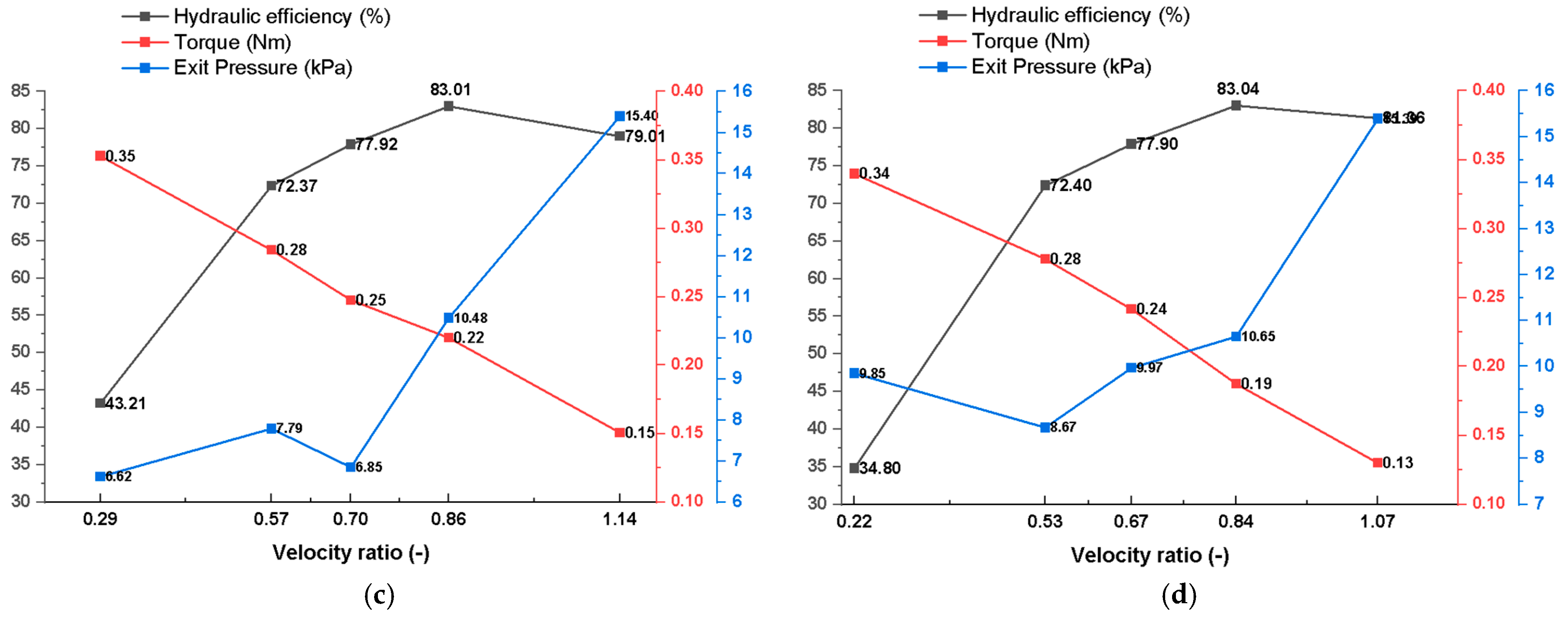
- ☞
- The flat blades exhibited consistently high exit pressures and low performance, highlighting ineffective flow redirection.
- ☞
- The round blades maintained moderate pressure and efficiency but lacked peak performance.
- ☞
- Sharp blades delivered high efficiency at select speeds, although they were susceptible to pressure spikes at higher rms.
- ☞
- Aerodynamic blades outperformed across all conditions, showing low exit pressures and consistent energy recovery, establishing them as the most suitable profile for performance-critical MHP applications.
3.10. Comparison with Prior Studies
4. Conclusions
5. Recommendations
- ☞
- Design Optimization: Future turbine designs should prioritize aerodynamic or sharp-edge profiles for improved hydraulic efficiency and internal flow stability, particularly in high-speed operations typical of decentralized energy systems.
- ☞
- Hybrid Geometry Exploration: A promising design avenue lies in hybrid blades that integrate a rounded leading edge (to suppress stagnation) with an aerodynamic trailing edge (to minimize separation), balancing manufacturability and performance.
- ☞
- Experimental Validation: To further support the simulation results, physical prototype testing under controlled conditions using PIV or LDA techniques is recommended for capturing transient effects and validating the turbulence behavior.
- ☞
- Three-Dimensional Modeling: Extending the study to three-dimensional and transient CFD simulations using LES or DES models would help capture secondary flow phenomena and assess unsteady behavior, particularly near blade tips and the runner-shaft interface.
- ☞
- Multi-objective Optimization: Incorporate techno-economic metrics into future design frameworks to simultaneously optimize hydraulic performance, material cost, and fabrication feasibility for scalable implementation in remote or resource-constrained regions.
Author Contributions
Funding
Data Availability Statement
Acknowledgments
Conflicts of Interest
Abbreviations
| Symbol | Description | Unit |
| αp | Volume fraction of a particular phase | - |
| Density of a particular phase | Kg/m3 | |
| Viscosity of a particular phase | ||
| Continuity equation source term for a particular phase | Kg/s | |
| relative velocity of the flow | m/s | |
| Effective viscosity | kg/m. s | |
| Turbulence viscosity | kg/m. s | |
| μ | Mean viscosity | (kg/m.s) |
| Angular velocity of the flow: | m/s | |
| Radius of the runner | m | |
| Angular acceleration | m2/s | |
| Linear acceleration | m2/s | |
∇ (-) | Momentum equation source term for a particular phase Del operator | N/m3 |
| Modified pressure | pa | |
| P | Pressure | Pa |
| Po | Reference pressure | pa |
| Absolute velocity of the flow | ||
| T | Transpose | - |
| t | Time | sec |
| k | Turbulence kinetic energy | J/kg |
| ε | Turbulent Dissipation rate | m3/s3 |
| ω | Turbulent frequency | s−1 |
| w | Volume fraction of water | - |
| a | Volume fraction of air | - |
| Constants | - | |
| ρ | Density of the fluid, and | (kg/m3) |
| γa | Air compressibility coefficient | - |
| Torque | N.m | |
| τ | The total stress tensor | Pa |
| s | Surface area | m2 |
| n | Unit Vector Perpendicular to the Surface | |
| r | Radial position of the vector | m |
| a | Unit vector parallel to the rotation axis | |
| Pturbine | Shaft power | kN |
| Pwater | Water power | kN |
| H | Effective net head | m |
| Q | Flow rate | m3/s |
| γ | Specific weight | N/m3 |
| Hydraulic efficiency | % | |
| V | Absolute water velocity | m/s |
| U | Peripheral blade velocity | m/s |
| W | Relative blade velocity | m/s |
| Vf | The radial velocity component | m/s |
| The tangential velocity component | m/s | |
| α | Angle of attack: 0° | deg |
| β | Blade angle | deg |
| ϴ | Angular (azimuthal)position | deg |
| h | Characteristic grid spacing | mm |
| Refinement ratio | - | |
| N | Number of cells | - |
| Relative error | % | |
| Observed order of accuracy | - | |
| Richardson’s extrapolated torque |
| Abbreviations | Description |
| PIV | Particle Image Velocimetry |
| LDA | Laser Doppler Anemometry |
| CFT | Cross-flow turbine |
| MHP | Micro hydropower |
| CFD | Computational fluid dynamics |
| SST | Shear-stress turbulence |
| WVF | Water volume fraction |
| GCI | Grid convergence index |
| FS | Safety Factor |
References
- International Energy Agency (IEA). Access to Electricity. Paris, France. Available online: http://www.iea.org/weo/electricity.asp (accessed on 24 January 2024).
- The High-Level Political Forum Goals Energy Action. Available online: https://hlpf.un.org/ (accessed on 19 February 2025).
- Eludoyin, E.O. The Nature of Sustainable Energy Access Transitions: Realities and possibilities for Lagos, Nigeria. Ph.D. Thesis, UCL Energy Institute, University College London, London, UK, 2018; 421p. Available online: http://discovery.ucl.ac.uk/10057177/7/Eludoyin_10057177_thesis_redacted_photo.pdf (accessed on 13 July 2023).
- Kaunda, C. Energy situation, potential and application status of small scale hydropower systems in Malawi. Renew. Sustain. Energy Rev. 2013, 26, 1–19. [Google Scholar] [CrossRef]
- Del Rio, J.S.; Galvis-Holguin, S.; Hincapié-Zuluaga, D.; Chica, E. Effect of hydrodynamically designed blades on the efficiency of a michell-banki turbine. Int. J. Renew. Energy Res. 2020, 10, 1165–1173. [Google Scholar] [CrossRef]
- Sammartano, V.; Aricò, C.; Carravetta, A.; Fecarotta, O.; Tucciarelli, T. Bank-Michell optimal design by computational fluid dynamic testing and hydynamic analysis. Energies 2013, 6, 2362–2385. [Google Scholar] [CrossRef]
- Muchtar, M.; Rasyid, S.; Nur, R. Welding fixture design for the production of cross-flow turbine runner. AIP Conf. Proc. 2018, 1977, 030020. [Google Scholar] [CrossRef]
- Adhikari, R.; Wood, D. The design of high efficiency crossflow hydro turbines: A review and extension. Energies 2018, 11, 267. [Google Scholar] [CrossRef]
- Baidar, B.; Koirala, R.; Neopane, H.P.; Shrestha, M.V.; Thapa, B. Strategic rehabilitation of the earthquake affected microhydropower plants in Nepal. IOP Conf. Ser. Earth Environ. Sci. 2016, 49, 102003. [Google Scholar] [CrossRef]
- Yildiz, V. Numerical Simulation Model of Run of River Hydropower Plants: Concepts, Numerical Modeling, Turbine System and Selection, and Design Optimization; University of California: Irvine, CA, USA, 2015; p. 84. [Google Scholar]
- Assefa, E.Y.; Tesfay, A.H. Effect of Blade Number on Internal Flow and Performance Characteristics in Low-Head Cross-Flow Turbines. Energies 2025, 18, 318. [Google Scholar] [CrossRef]
- Yadav, V.K.; Singal, S.K. Performance analysis of cross-flow turbine: Variation in shaft diameter. In Development of Water Resources in India. Water Science and Technology Library; Springer: Cham, Switzerland, 2017; Volume 75, pp. 487–497. [Google Scholar]
- Guo, Q.; Zhou, L.; Wang, Z. Numerical evaluation of the clearance geometries effect on the flow field and performance of a hydrofoil. Renew. Energy 2016, 99, 390–397. [Google Scholar] [CrossRef]
- Adanta, D.; Sari, D.P.; Syofii, I.; Prakoso, A.P.; Saputra, M.A.A.; Thamrin, I. Performance Comparison of Crossflow Turbine Configuration Upper Blade Convex and Curvature by Computational Method. Civ. Eng. J. 2023, 9, 154–165. [Google Scholar] [CrossRef]
- Desai, V.R.; Aziz, N.M. An experimental investigation of cross-flow turbine efficiency. J. Fluids Eng. Trans. ASME 1994, 116, 545–550. [Google Scholar] [CrossRef]
- Anand, R.S.; Jawahar, C.P.; Bellos, E.; Malmquist, A. A comprehensive review on Crossflow turbine for hydropower applications. Ocean. Eng. 2021, 240, 110015. [Google Scholar] [CrossRef]
- Woldemariam, E.T.; Lemu, H.G.; Wang, G.G. CFD-driven valve shape optimization for performance improvement of a micro cross-flow turbine. Energies 2018, 11, 248. [Google Scholar] [CrossRef]
- Rasmussen, I.J. Design of a Francis Model Test Rig at Kathmandu University. Master’s Thesis, Institutt for Energi-og Prosessteknikk, Trondheim, Norway, 2014. [Google Scholar]
- Sinagra, M.; Picone, C.; Aricò, C.; Pantano, A.; Tucciarelli, T.; Hannachi, M.; Driss, Z. Impeller optimization in crossflow hydraulic turbines. Water 2021, 13, 313. [Google Scholar] [CrossRef]
- Chelabi, M.A.; Dobrotvorskiy, S.; Basova, Y.; Aleksenko, B.A.; Edl, M.; Zdebor, J.; Machado, J. Influence of the Main Geometrical Parameters on the Design and Performance of Mixed Inflow Turbines. Appl. Sci. 2022, 12, 12165. [Google Scholar] [CrossRef]
- Naseem, M.; Saleem, A.; Naseem, M.S. Investigation of blade design parameters for performance improvement of hydraulic cross flow turbine. Ocean Eng. 2022, 257, 111663. [Google Scholar] [CrossRef]
- Urame, C.; Hoole, P.R. Design and Implementation of Hybrid Pico-Hydro—Photovoltaic (PV) Solar Power Plant in Massy-Gahuku LLG. Eur. J. Electr. Eng. 2020, 22, 395–403. [Google Scholar] [CrossRef]
- Sedlar, M.; Ji, B.; Kratky, T.; Rebok, T.; Huzlik, R. Numerical and experimental investigation of three-dimensional cavitating flow around the straight NACA2412 hydrofoil. Ocean Eng. 2016, 123, 357–382. [Google Scholar] [CrossRef]
- Georgescu, A.M.; Georgescu, S.C.; Degeratu, M. Experimental setup designed for testing a cross-flow water turbine in a wind tunnel. UPB Sci. Bull. Ser. D Mech. Eng. 2008, 70, 191–200. [Google Scholar]
- Japan International Cooperation Agency. Guideline and Manual for Hydropower Development Vol. 2. Small Scale Hydropower. 2011. Available online: https://openjicareport.jica.go.jp/pdf/12024881_01.pdf (accessed on 3 April 2025).
- Oberkampf, W.L.; Trucano, T.G. Verification and validation in computational fluid dynamics. Prog. Aerosp. Sci. 2002, 38, 209–272. [Google Scholar] [CrossRef]
- Menter, F.R.; Kuntz, M.; Langtry, R. Ten Years of Industrial Experience with the SST Turbulence Model Turbulence heat and mass transfer. Turbul. Heat Mass Transf. 2004, 4, 625–632. [Google Scholar]
- Phillips, T.S.; Roy, C.J. Richardson extrapolation-based discretization uncertaint estimation for computational fluid dynamics. J. Fluids Eng. Trans. ASME 2014, 136, 121401. [Google Scholar] [CrossRef]
- Ahn, S.Y.; Kim, K.Y. Thermal performance of t-shaped obstacles in a solar air heater. Processes 2020, 8, 1305. [Google Scholar] [CrossRef]
- Kaunda, C.S.; Kimambo, C.Z.; Nielsen, T.K. A numerical investigation of flow profile and performance of a low cost crossflow turbine. Int. J. Energy Envrion. 2014, 5, 275–296. [Google Scholar]
- Javaherchi, T.; Stelzenmuller, N.; Seydel, J.; Aliseda, A. Experimental and Numerical Analysis of a Scale-Model Horizontal Axis Hydrokinetic Turbine. In Proceedings of the 2nd Marine Energy Technology Symposium METS2014, Seattle, WA, USA, 15–18 April 2014. [Google Scholar]
- Menter, F.R.; Sechner, R.; Matyushenko, A. Best Practice: RANS Turbulence Modeling in ANSYS CFD. 2021. 295p. Available online: https://www.ansys.com/resource-center/technical-paper/best-practice-rans-turbulence-modeling-in-ansys-cfd (accessed on 19 February 2025).
- Ibrahim, B.; Chattha, J.A.; Asif, M. Optimization of Blade Profiles of Cross Flow Turbine (CFT). Int. J. Power Energy Convers. IJPEC 2018, 9, 311–326. [Google Scholar] [CrossRef]
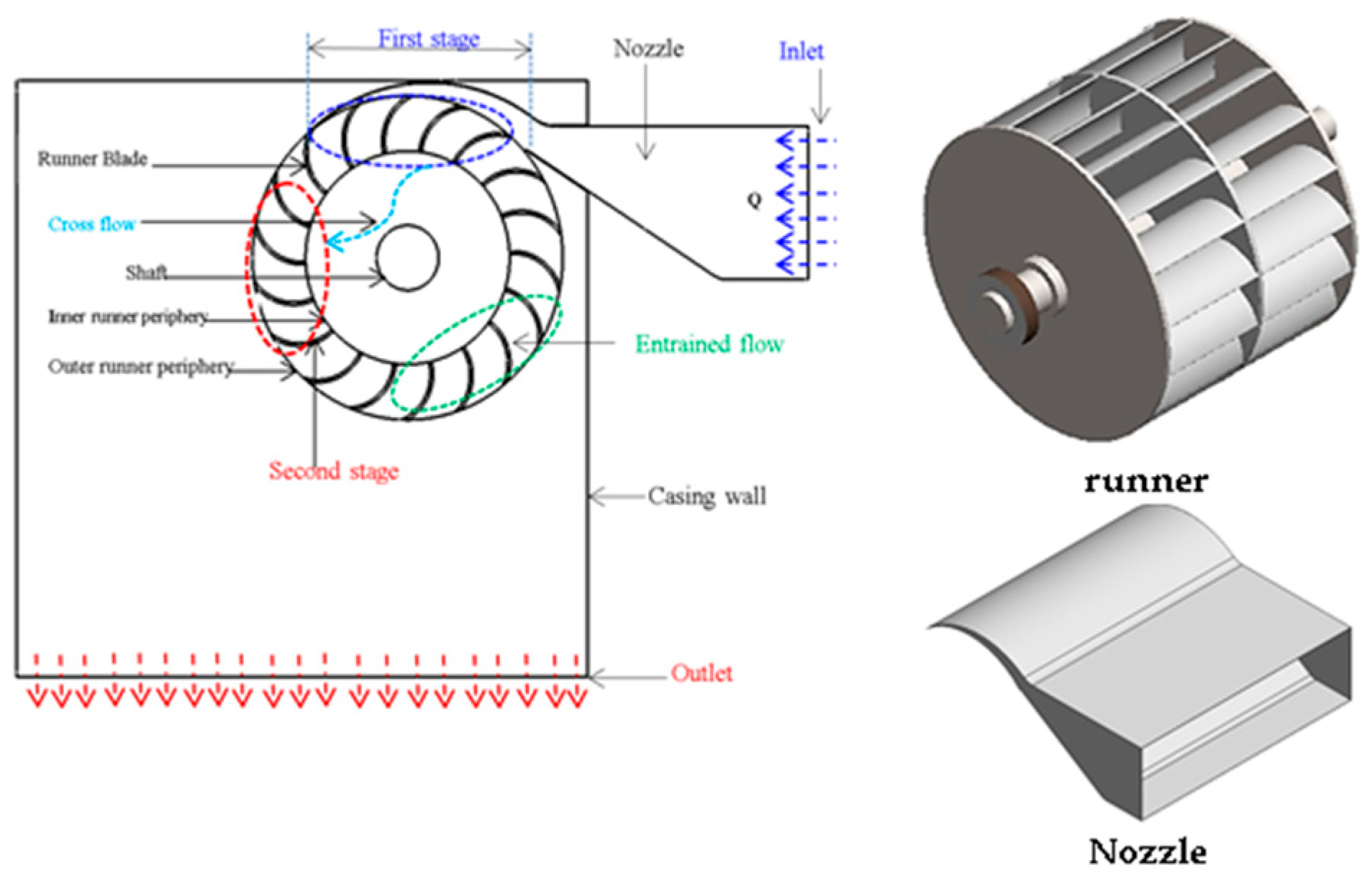

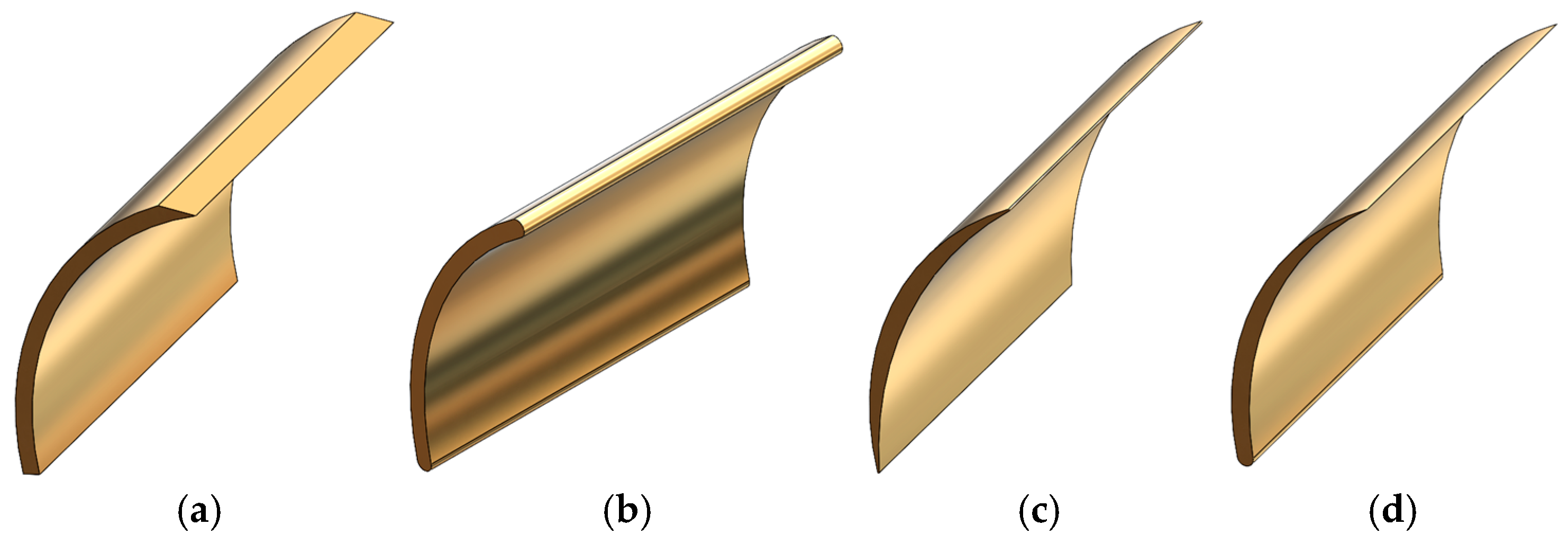


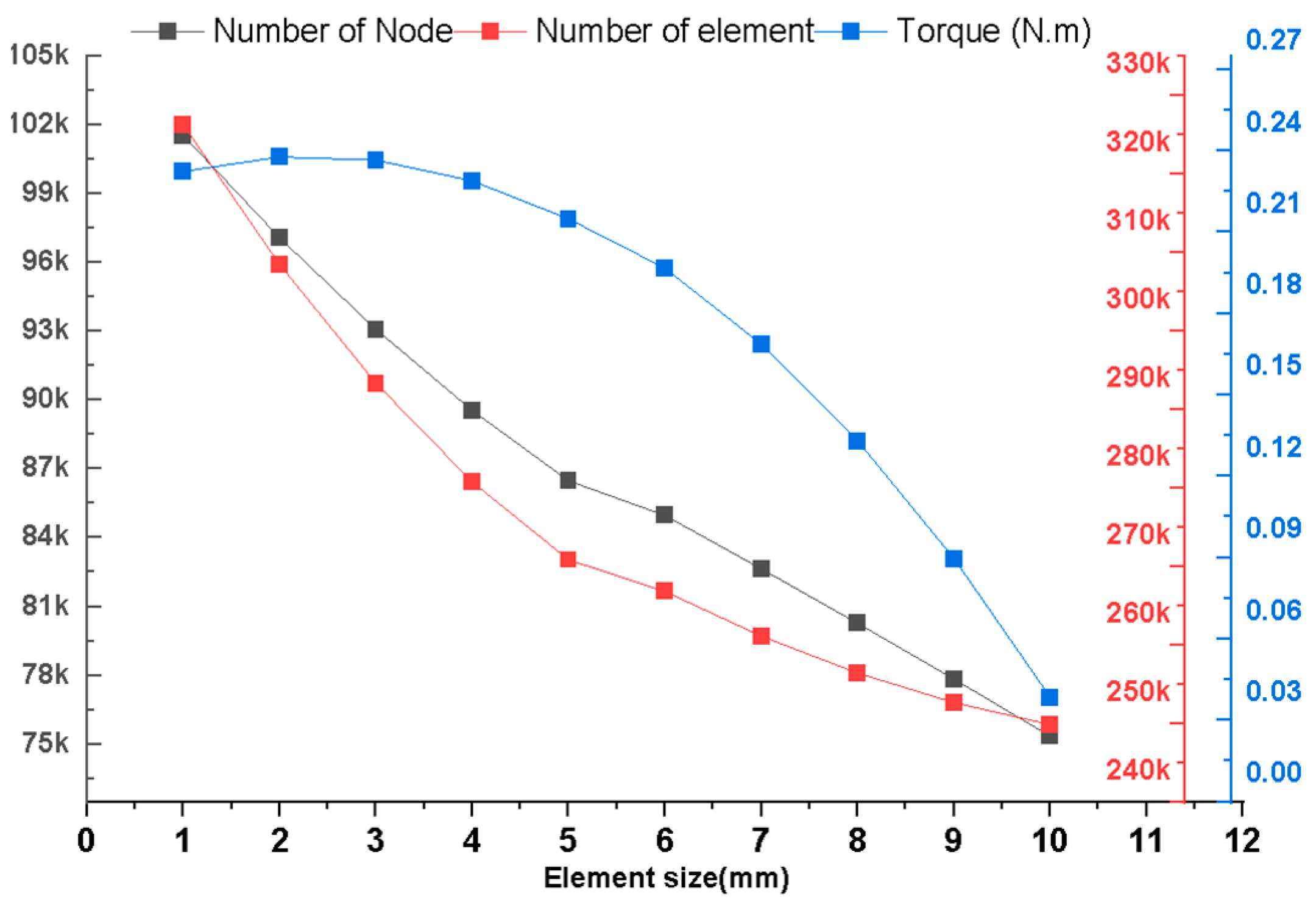

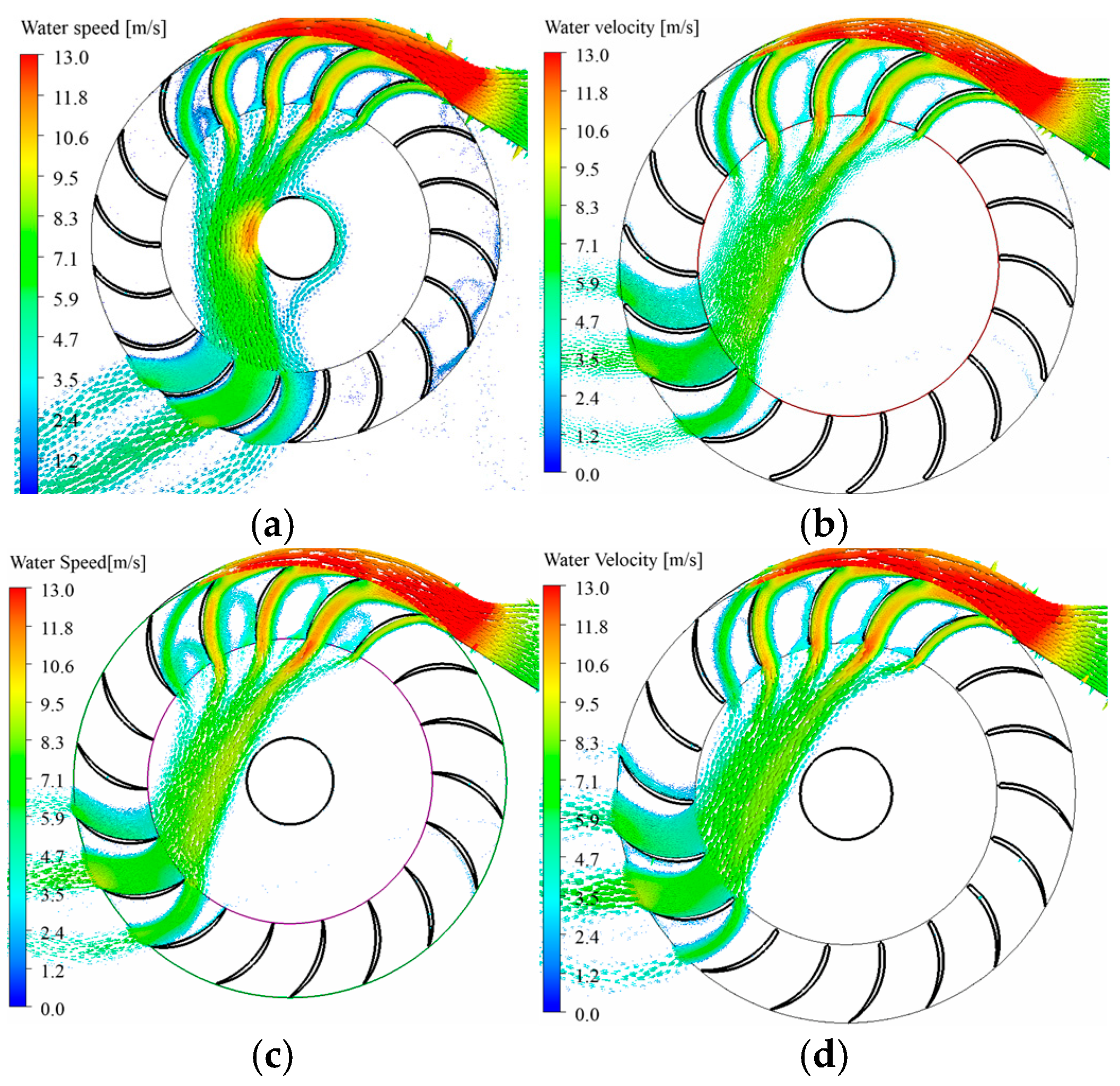
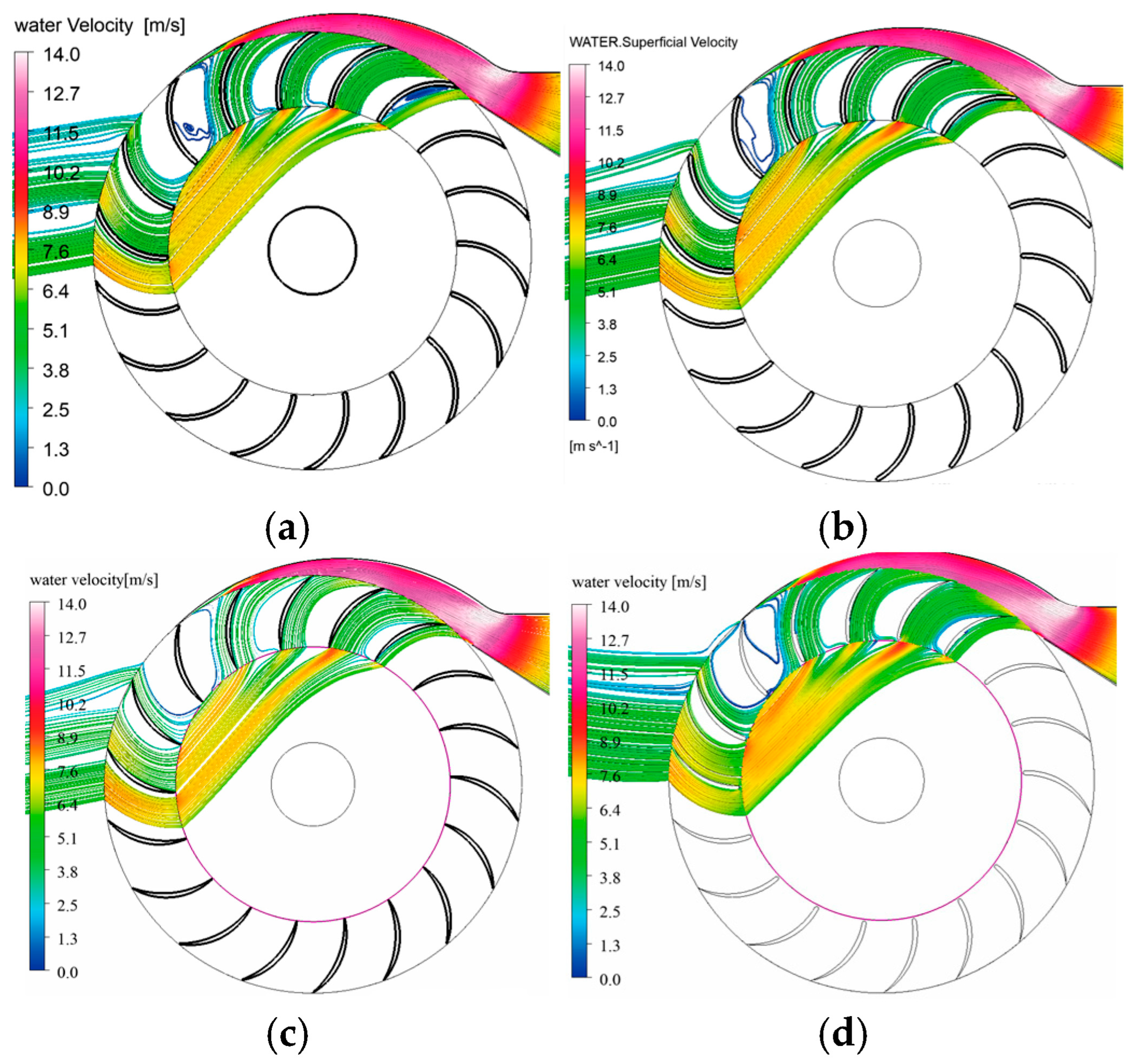
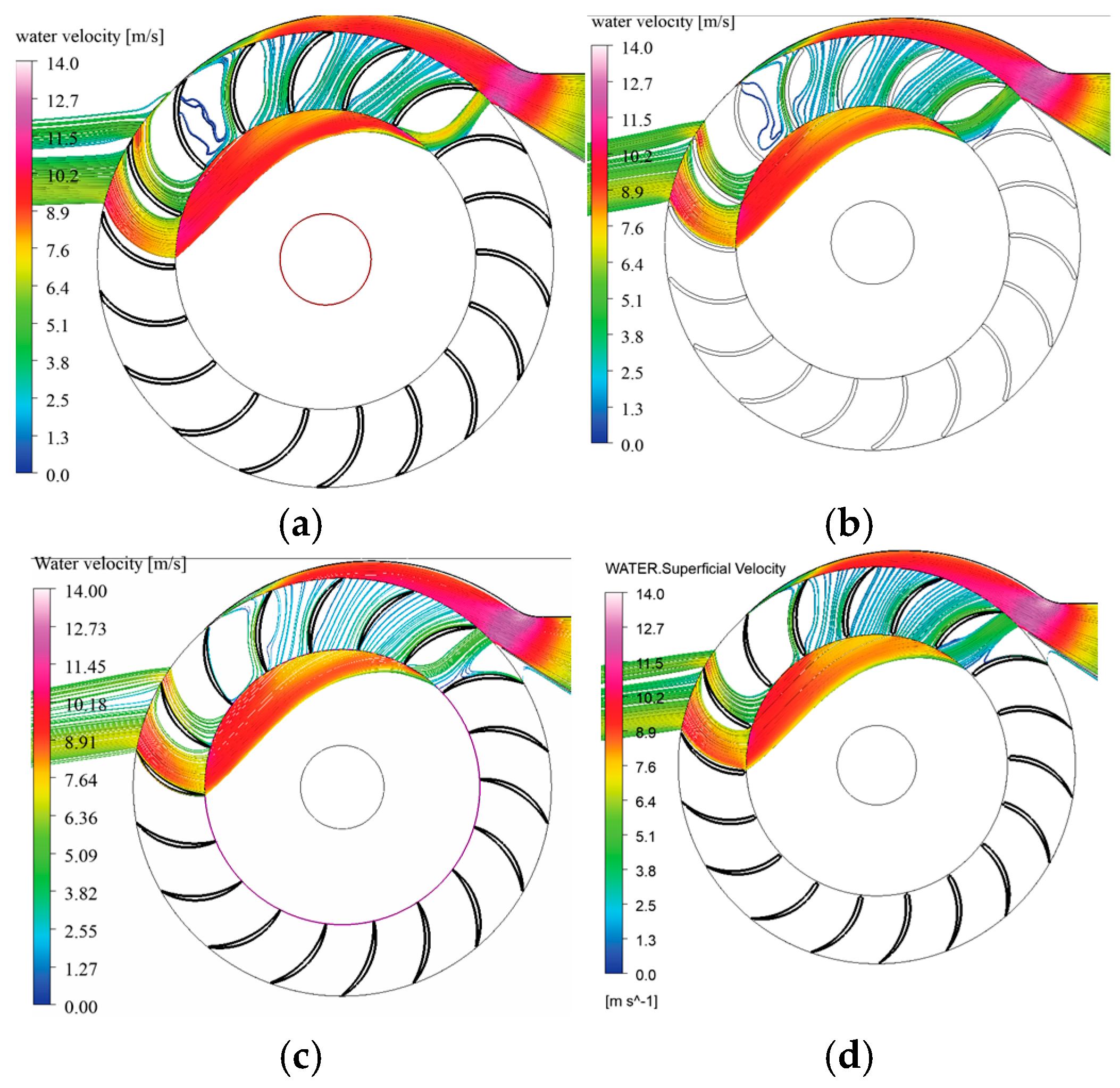


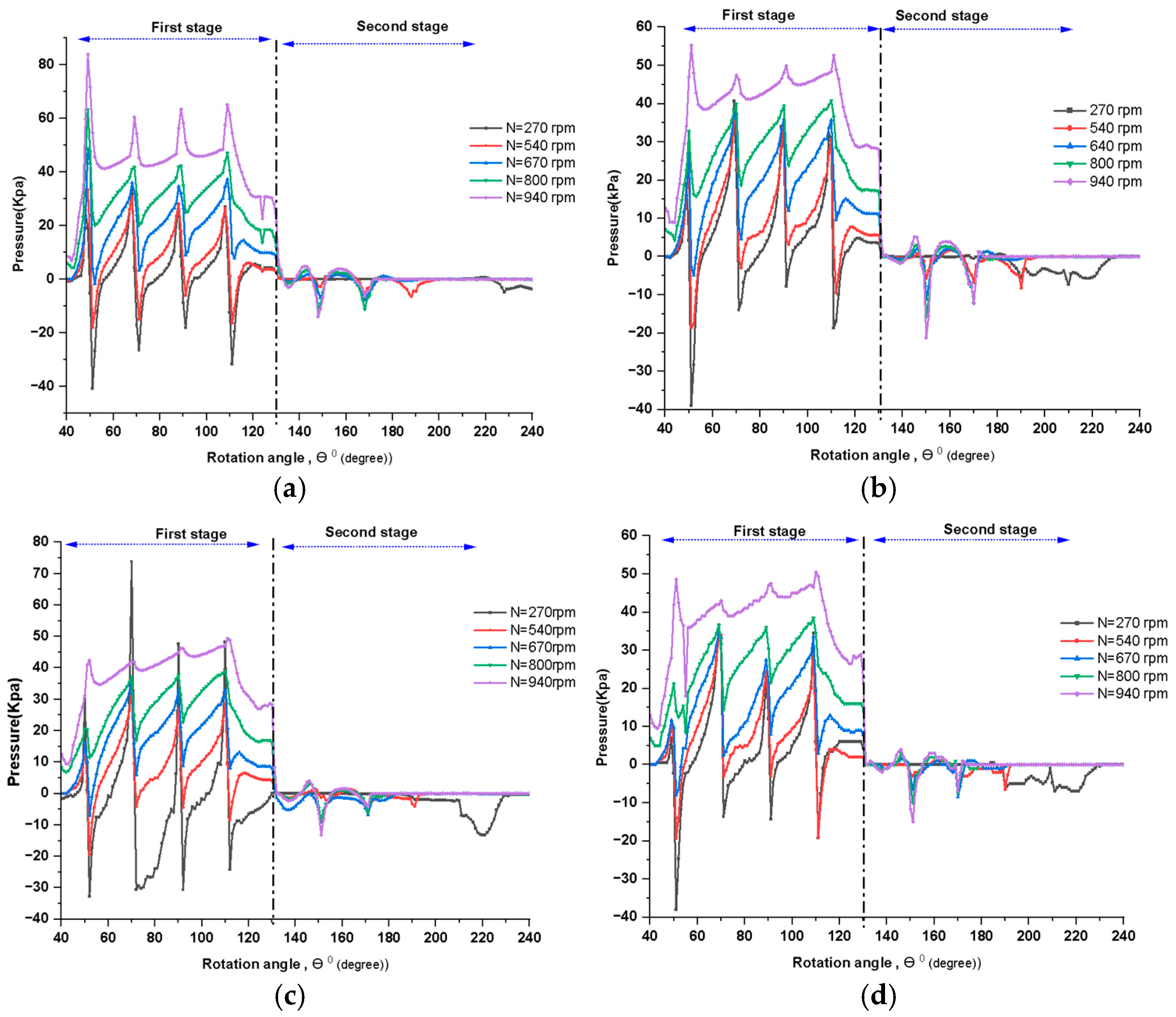
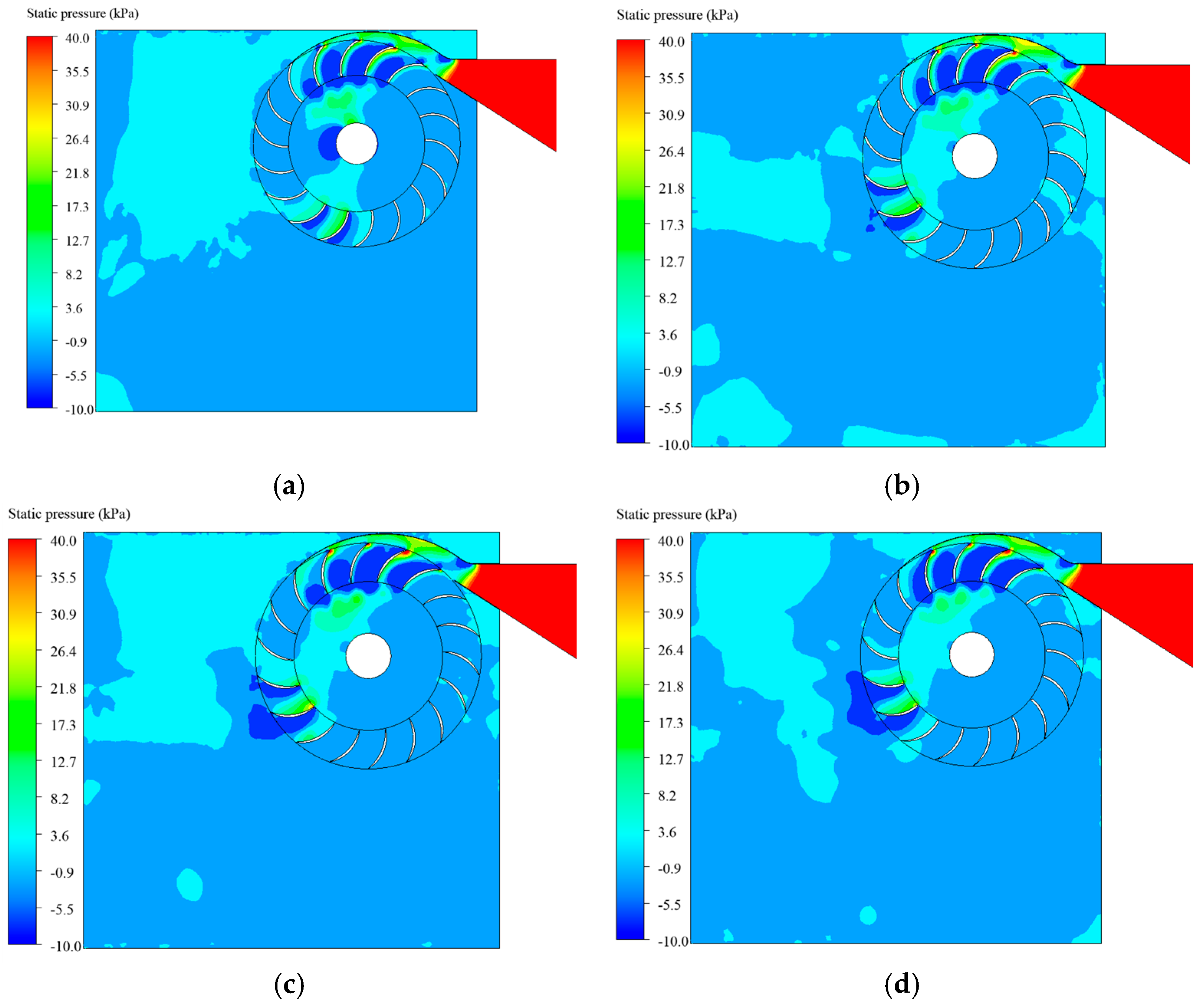

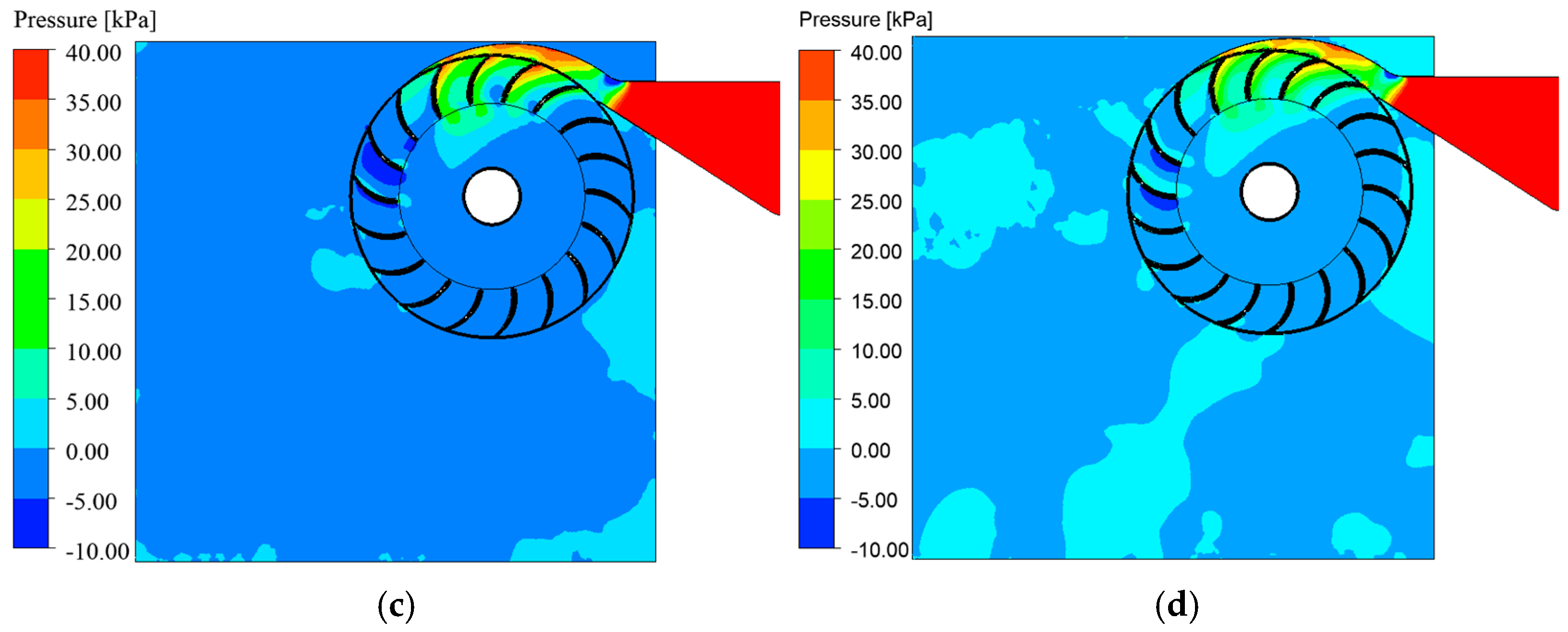
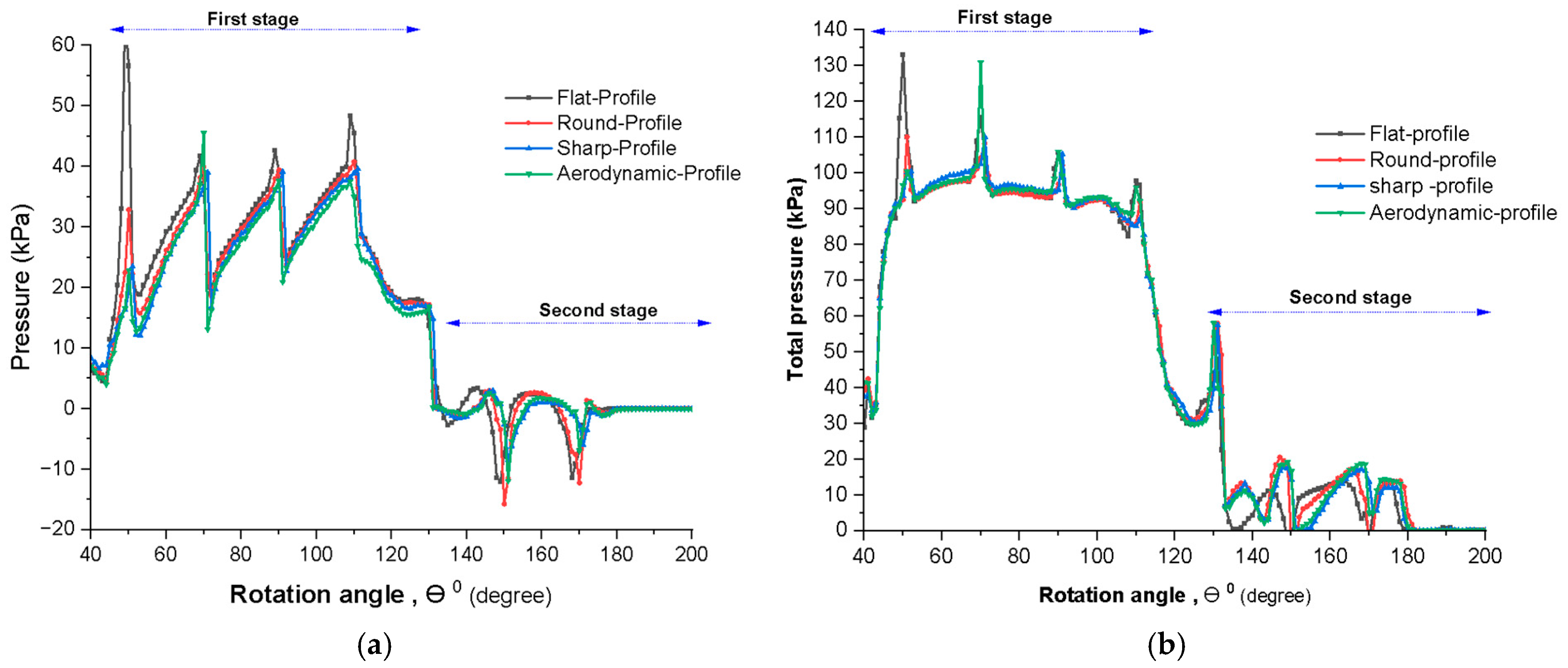
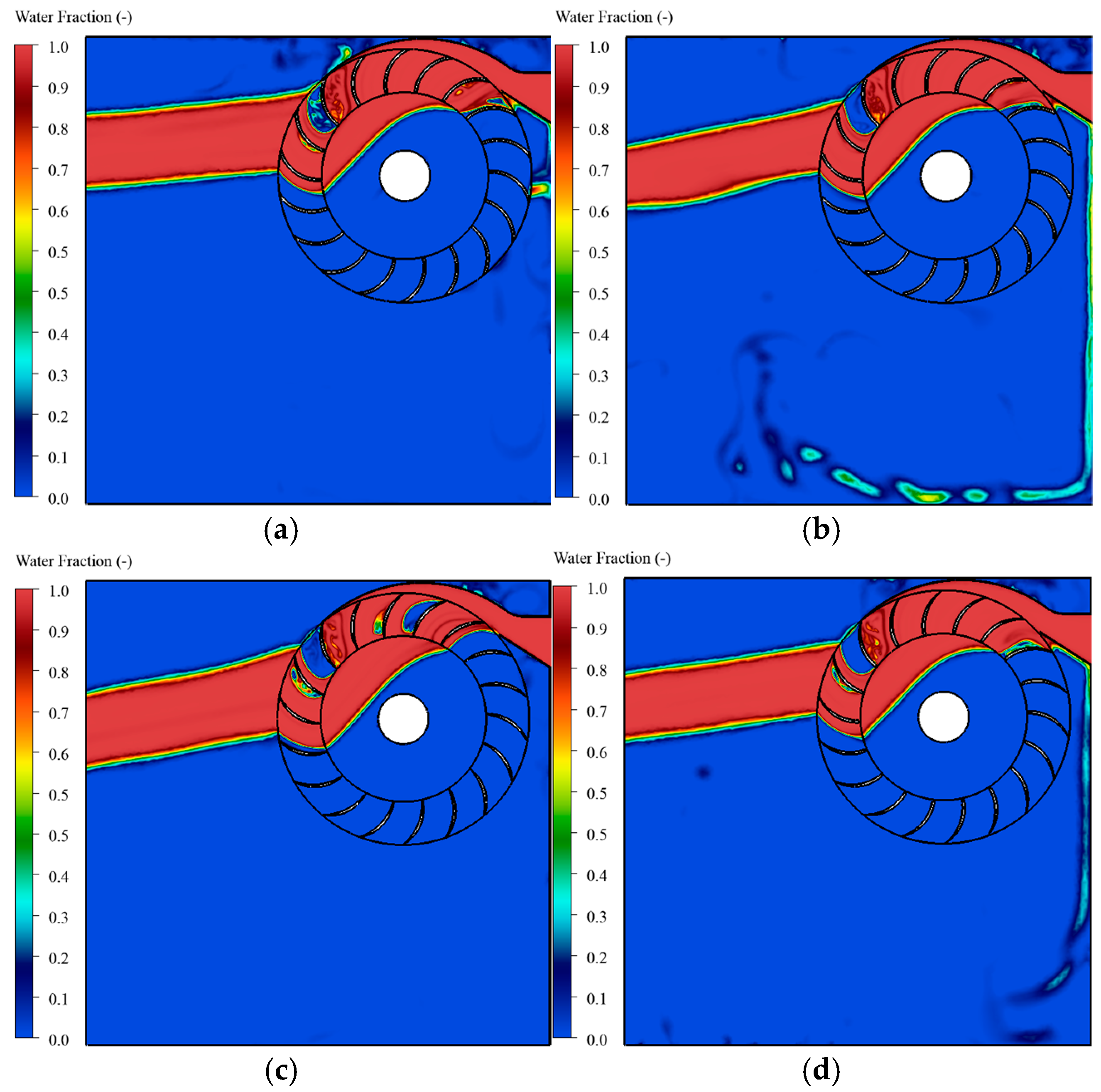
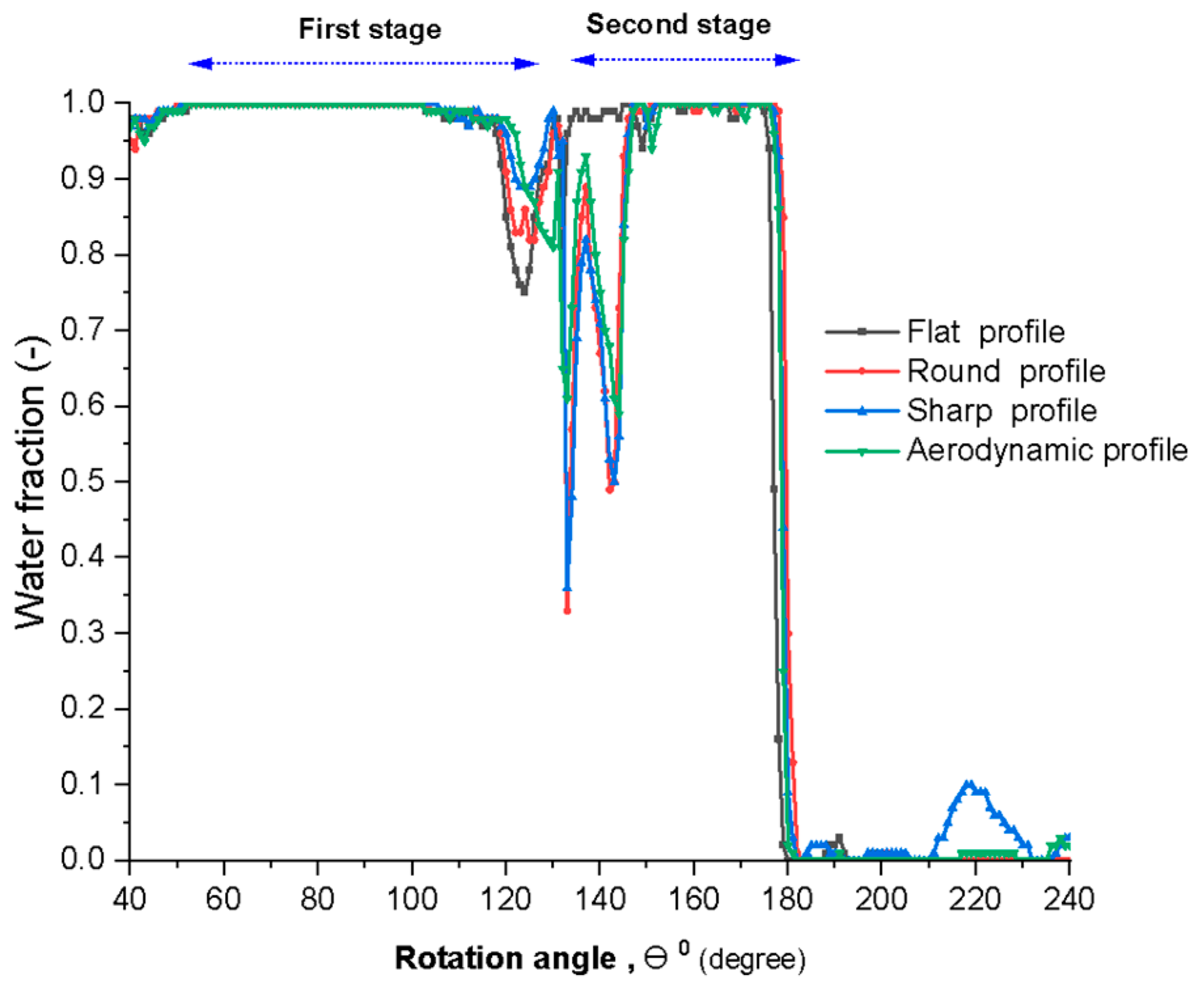
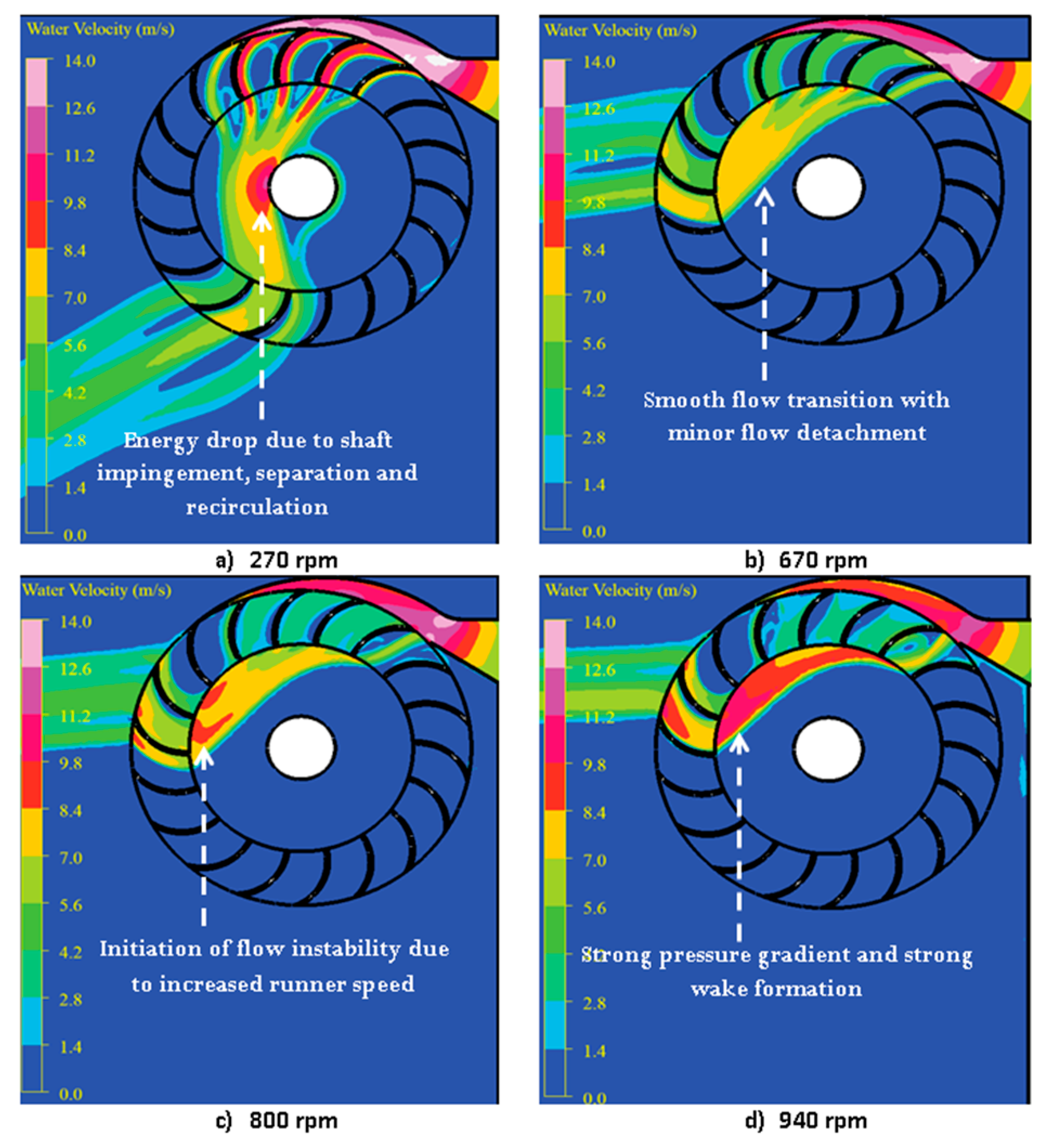
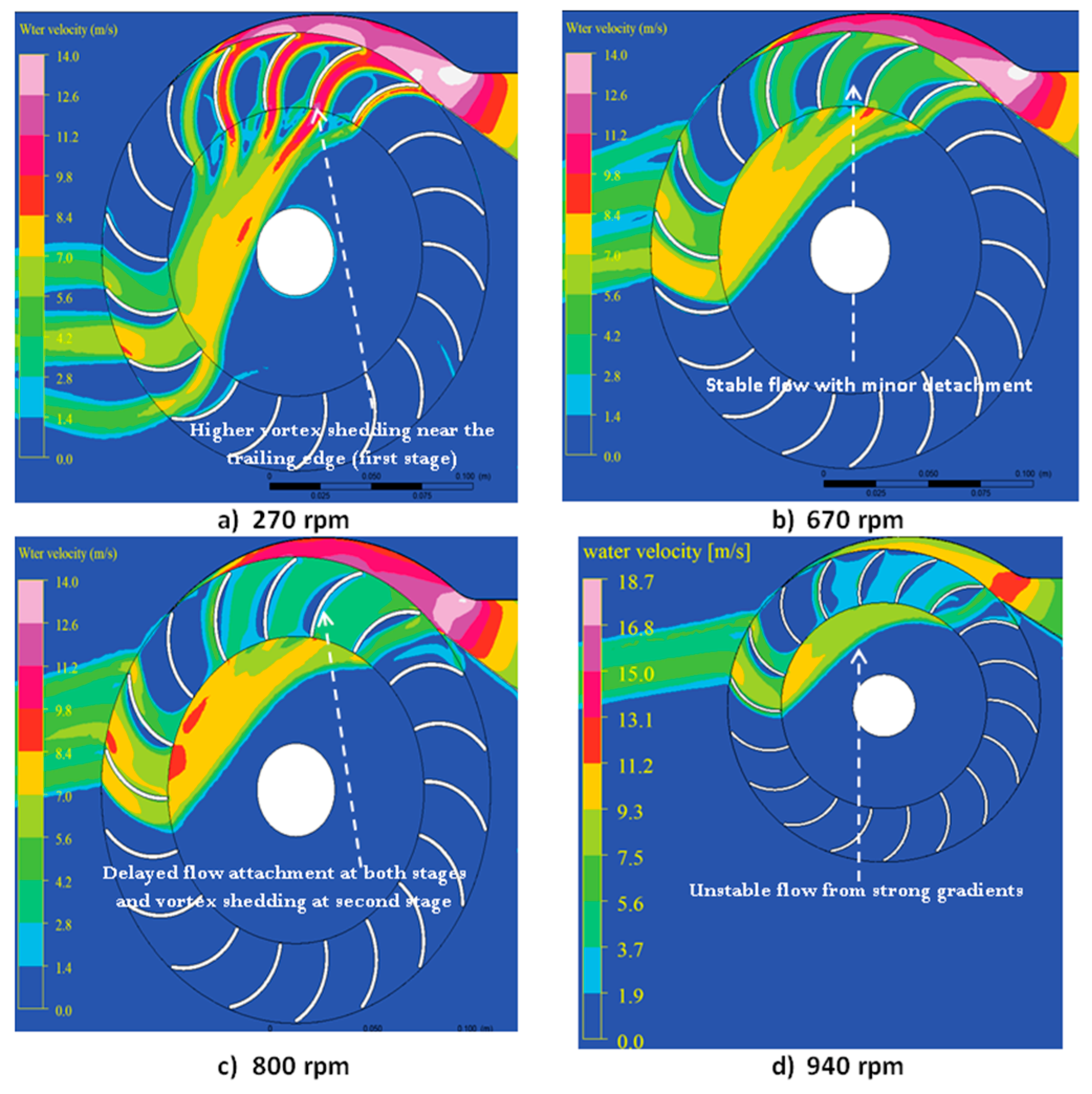
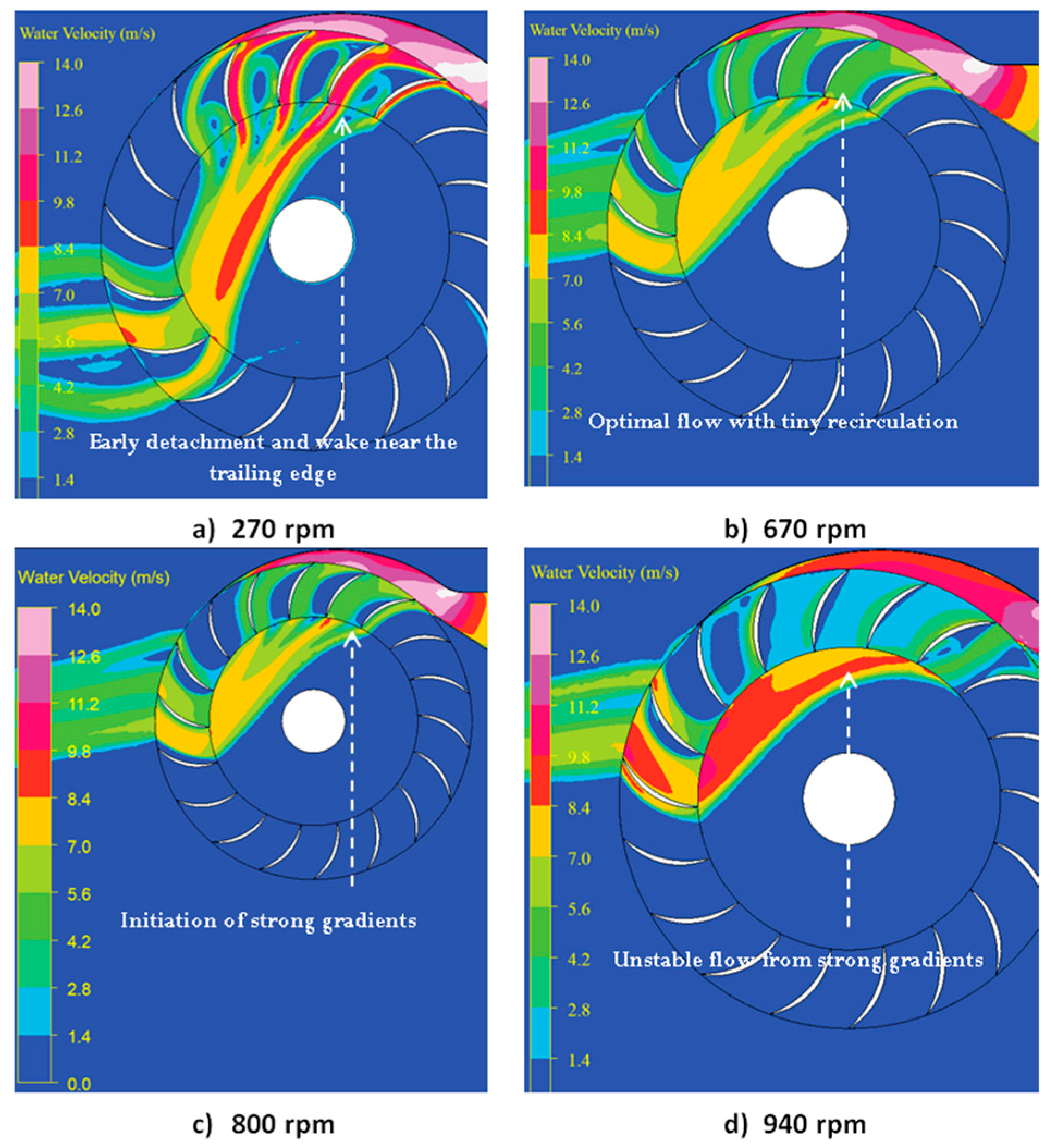

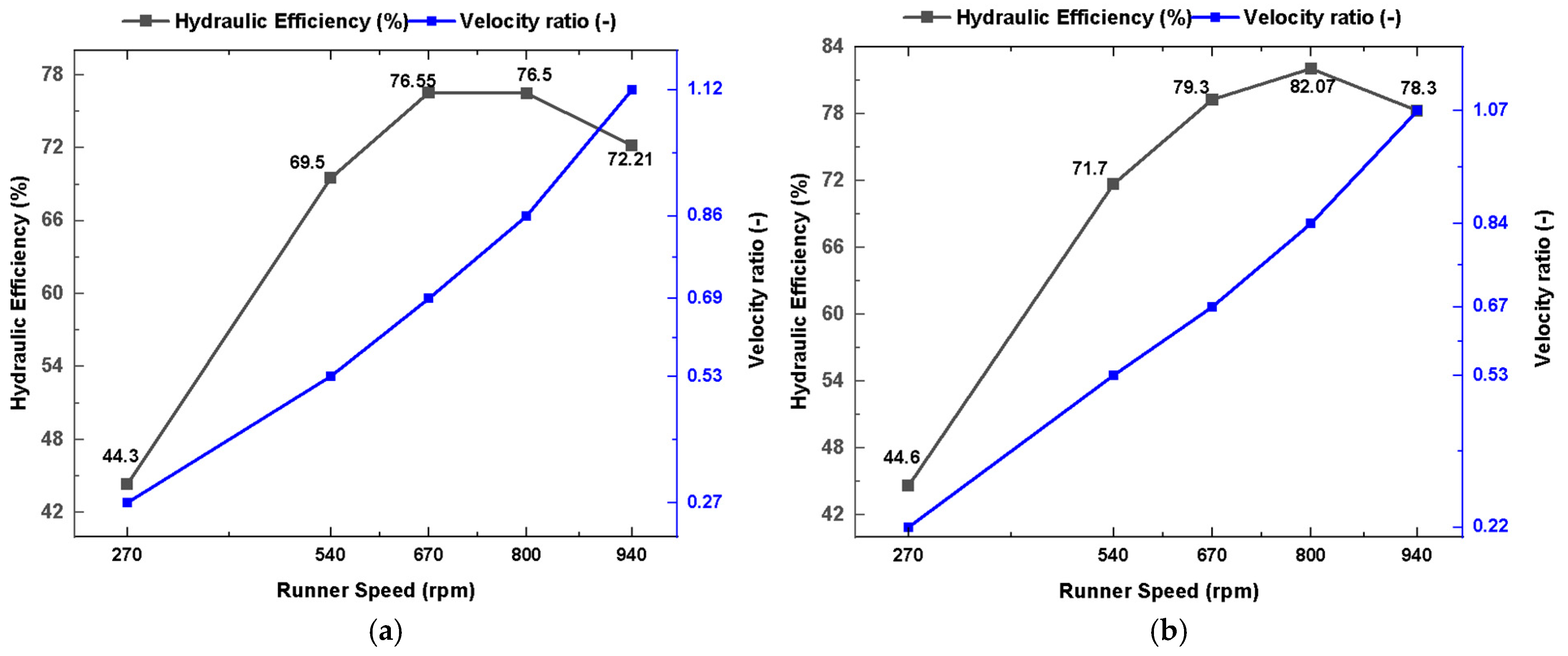

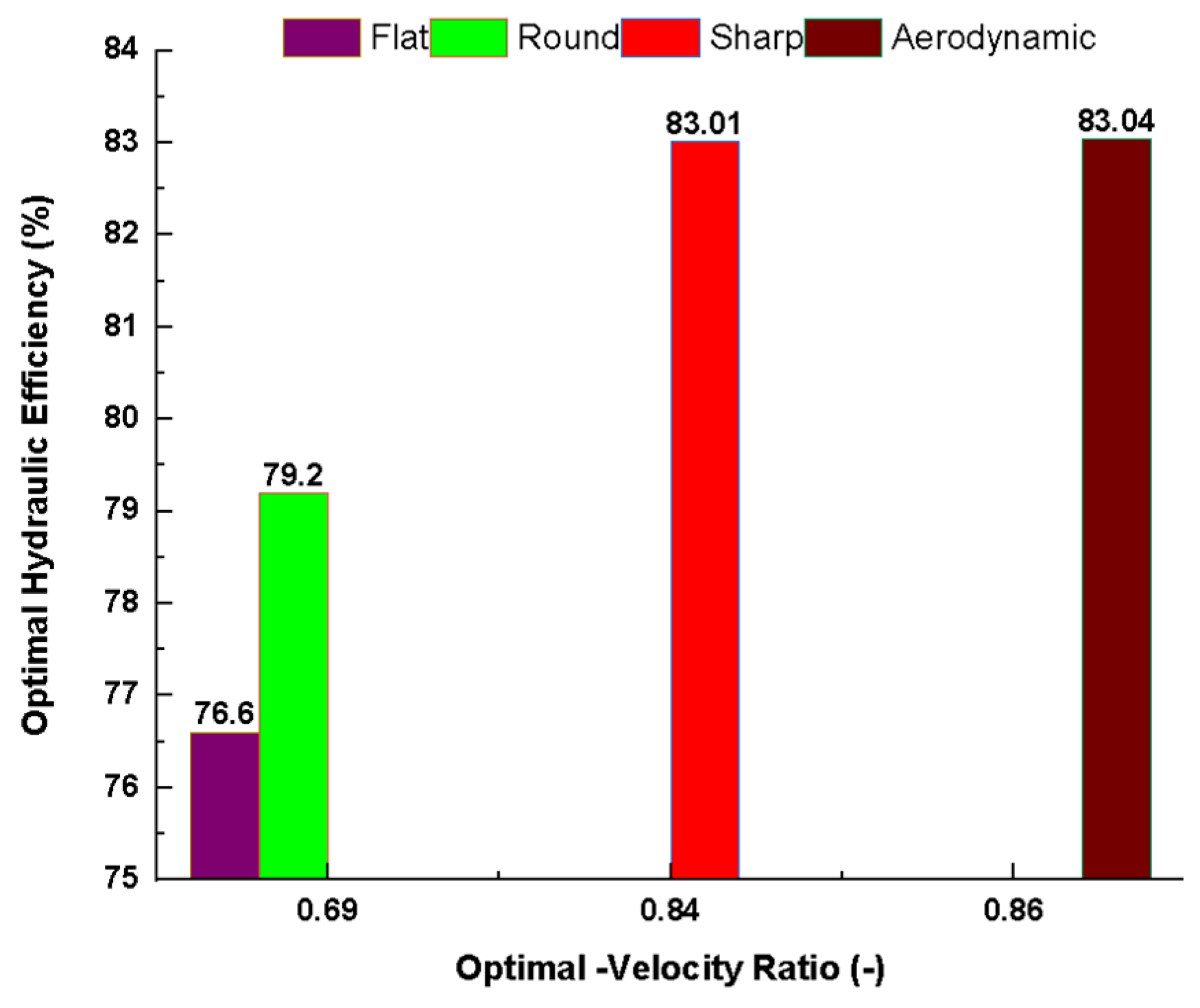

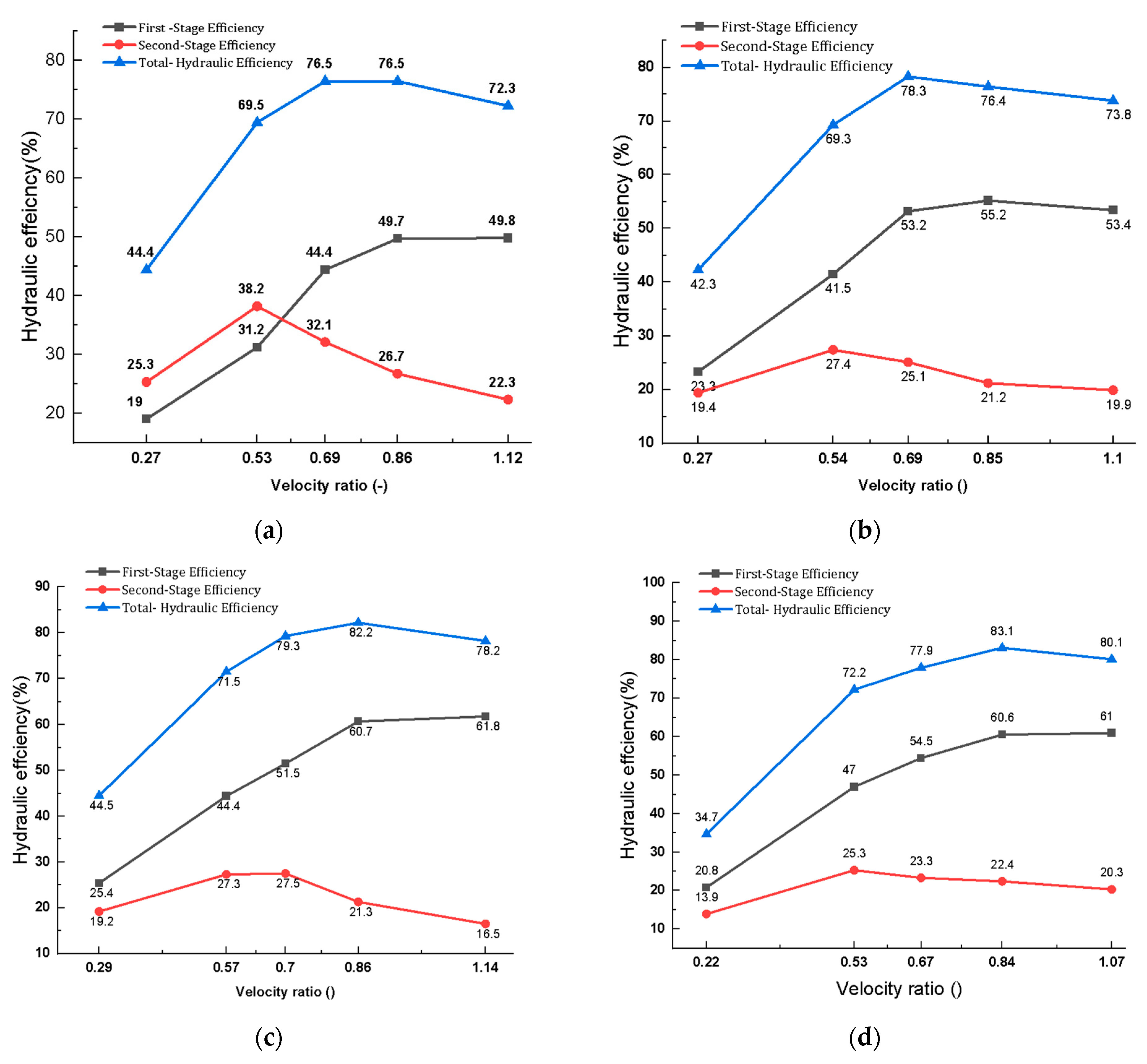

| Design Parameter | Symbol | Value | Unit |
|---|---|---|---|
| Effective pressure head | H | 10 | m |
| Flow rate | Q | 55 | l/s |
| Flow attack angle | 16 | deg | |
| Blade entry angle (1st stage) | 30 | deg | |
| Blade exit angle (1st stage) | 90 | deg | |
| Optimal runner speed | N | 670 | rpm |
| Outer runner diameter | 200 | mm | |
| Inner runner diameter | 130 | mm | |
| Diameter ratio | 0.66 | - | |
| Jet thickness | 17 | mm | |
| Blade spacing | 34 | mm | |
| Number of blades | 18 | - | |
| Blade thickness (except sharp) | t | 3 | mm |
| Nozzle entry arch angle | λ | 90 | deg |
| Blade curvature radius | 33 | mm | |
| Central angle | 73.5 | deg | |
| Blade width | 225 | mm |
| Grid Level | Number of Cells (N) | Torque (Nm) | Grid Spacing (h) |
|---|---|---|---|
| Coarse | 321,500 | 0.243 | 0.00176 |
| Medium | 620,000 | 0.2435 | 0.00127 |
| Fine | 915,600 | 0.2438 | 0.00105 |
| Parameters | Symbol | Value | Unit |
|---|---|---|---|
| Fine-to-medium refinement ratio | 1.39 | - | |
| Medium-to-coarse refinement ratio | 1.22 | - | |
| Observed order of accuracy | 0.33 | - | |
| Richardson’s extrapolated torque | 0.25 | N.m | |
| Relative Error (fine-to-medium) | ) | 0.0013 | - |
| Relative Error (medium-to-coarse) | ) | 0.0014 | - |
| Grid Convergence Index (fine-to-medium) | GCI_21 | 1.38 | (%) |
| Grid Convergence Index (medium-to-coarse) | GCI_32 | 1.56 | (%) |
| Blade Profile | Low Runner Speed (270–540 rpm) | Medium Runner Speed (540–640 rpm) | Higher Runner Speed (800–940 rpm) | Hydraulic Performance |
|---|---|---|---|---|
| Flat | High separation, strong recirculation | Vortex shedding, unstable wake | Severe instability, low efficiency | Poor |
| Round | Improved flow, minor voids | Stable flow with minor detachment | Coherent vortex structure | Moderate |
| sharp | Early detachment, vortex near the root | Optimal flow redirection | Unstable from strong gradients | Speed dependent |
| Aerodynamic | Attached flow, minimal wake | Stable, efficient pressure recovery | Delayed separation, reduced shedding | High efficiency across most speed ranges |
Disclaimer/Publisher’s Note: The statements, opinions and data contained in all publications are solely those of the individual author(s) and contributor(s) and not of MDPI and/or the editor(s). MDPI and/or the editor(s) disclaim responsibility for any injury to people or property resulting from any ideas, methods, instructions or products referred to in the content. |
© 2025 by the authors. Licensee MDPI, Basel, Switzerland. This article is an open access article distributed under the terms and conditions of the Creative Commons Attribution (CC BY) license (https://creativecommons.org/licenses/by/4.0/).
Share and Cite
Assefa, E.Y.; Tesfay, A.H. Effect of Blade Profile on Flow Characteristics and Efficiency of Cross-Flow Turbines. Energies 2025, 18, 3203. https://doi.org/10.3390/en18123203
Assefa EY, Tesfay AH. Effect of Blade Profile on Flow Characteristics and Efficiency of Cross-Flow Turbines. Energies. 2025; 18(12):3203. https://doi.org/10.3390/en18123203
Chicago/Turabian StyleAssefa, Ephrem Yohannes, and Asfafaw Haileselassie Tesfay. 2025. "Effect of Blade Profile on Flow Characteristics and Efficiency of Cross-Flow Turbines" Energies 18, no. 12: 3203. https://doi.org/10.3390/en18123203
APA StyleAssefa, E. Y., & Tesfay, A. H. (2025). Effect of Blade Profile on Flow Characteristics and Efficiency of Cross-Flow Turbines. Energies, 18(12), 3203. https://doi.org/10.3390/en18123203







